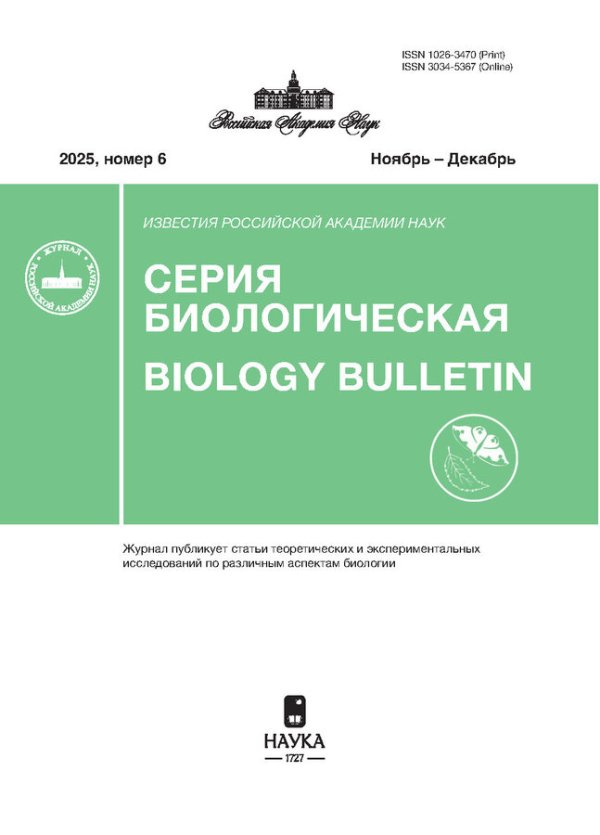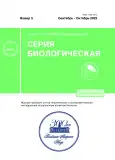Смертность насекомых под воздействием бакуловируса: модель фазовых переходов второго рода
- Авторы: Суховольский В.Г.1, Куренщиков Д.К.2, Иванова Ю.Д.3, Ковалев А.В.4
-
Учреждения:
- Институт леса им. В.Н. Сукачева – обособленное подразделение ФИЦ КНЦ СО РАН
- Институт водных и экологических проблем ХФИЦ ДВО РАН
- Институт биофизики – обособленное подразделение ФИЦ КНЦ СО РАН
- ФИЦ КНЦ СО РАН
- Выпуск: № 5 (2023)
- Страницы: 557-567
- Раздел: ЭКОЛОГИЯ
- URL: https://journals.rcsi.science/1026-3470/article/view/135561
- DOI: https://doi.org/10.31857/S1026347022600595
- EDN: https://elibrary.ru/WIYGJR
- ID: 135561
Цитировать
Полный текст
Аннотация
Рассмотрена возможность применения математической модели фазовых переходов второго рода с двумя свободными параметрами для описания эпизоотии кольчатого шелкопряда Malacosoma neustria L. и непарного шелкопряда Lymantria dispar L. под воздействием вируса ядерного полиэдроза. Для оценки чувствительности насекомых к воздействию бакуловирусов проводились лабораторные эксперименты по оценке выживаемости гусениц под различной инфекционной нагрузкой. В модели описывался процесс гибели особей в зависимости от двух факторов – титра вирусов как дозы воздействия и продолжительности жизни особи в зависимости от титра вирусов. Информация о продолжительности жизни насекомых после воздействия вируса представлена в виде функции выживания. В настоящей работе рассмотрена возможность построения модели времени жизни насекомых после воздействия бакуловирусов как аналога фазового перехода второго рода в физических системах и даны оценки параметров моделей для двух видов насекомых при разных титрах бакуловирусов и при разном возрасте гусениц. Показано, что продолжительность латентного периода и времени гибели всех особей в выборке линейно уменьшается с ростом логарифма титра вирусов.
Об авторах
В. Г. Суховольский
Институт леса им. В.Н. Сукачева – обособленное подразделение ФИЦ КНЦ СО РАН
Автор, ответственный за переписку.
Email: soukhovolsky@yandex.ru
Россия, 660036, Красноярск, Академгородок, 50/28
Д. К. Куренщиков
Институт водных и экологических проблем ХФИЦ ДВО РАН
Email: soukhovolsky@yandex.ru
Россия, 680000, Хабаровск, ул. Дикопольцева, 56
Ю. Д. Иванова
Институт биофизики – обособленное подразделение ФИЦ КНЦ СО РАН
Email: soukhovolsky@yandex.ru
Россия, 660036, Красноярск, Академгородок, 50/50
А. В. Ковалев
ФИЦ КНЦ СО РАН
Email: soukhovolsky@yandex.ru
Россия, 660036, Красноярск, Академгородок, 50
Список литературы
- Исаев А.С., Хлебопрос Р.Г., Недорезов Л.В., Кондаков Ю.П., Киселев В.В., Суховольский В.Г. Популяционная динамика лесных насекомых. М.: Наука, 2001. 374 с.
- Ландау Л.Д., Лифшиц Е.М. Теоретическая физика Статистическая физика. Ч. I. М.: Наука, 1976. 584 с.
- Anderson R.M., May R.M. Infectious diseases and population cycles of forest insects // Science. 1980. V. 210. P. 658–661.
- Bailey D., Chandler W.P., Grant J., Greaves G., Prince M. Tatchell. Biopesticides: Pest Management and Regulation. CABI International, Wallingford. 2010. 232 p.
- Bonsall M., Godfray H.C.J., Briggs C., Hassell M.P. Does host self-regulation increase the likelihood of insect-pathogen population cycles? // Am. Nat. 1999. V. 153. P. 228–235.
- Boots M., Norman R. Sublethal infection and the population dynamics of host-microparasite interactions // J. Anim. Ecol. 2000. V. 69. P. 517–524.
- Bowers R., Begon M., Hodgkinson D. Host-pathogen population cycles in forest insects? Lessons from simple models reconsidered // Oikos. 1993. V. 67. P. 529–538.
- Briggs C.J., Godfray H.C.J. The dynamics of insect-pathogen interactions in seasonal environments // Theor. Popul. Biol. 1996. V. 50. P. 149–177.
- Bruce A.D., Cowley R.A. Structural phase transitions. L.: Taylor & Francis, 1981. 326 p.
- Copping L.G., Menn J.J. Biopesticides: a review of their actions, applications and efficacy// Pest Manage Sci. 2000. V. 56. P. 651–676.
- Cory J.S., Clarke E.E., Brown M.L., Hails R.S., O’Reilly D.R. Microparasite manipulation of an insect: the influence of the egt gene on the interaction between a baculovirus and its lepidopteran host // Funct. Ecol. 2004. V. 18. P. 443–450.
- Cory J.S., Myers J.H. The ecology and evolution of insect baculoviruses // Ann. Rev. Ecol. Evol. Syst. 2003. V. 34. P. 239–272.
- Cox D.R., Oakes D. Analysis of survival data. CRC Press, Boca Raton, 1984. 208 p.
- Dwyer G., Dushoff J., Elkinton J.S., Levin S.A. Pathogen-driven outbreaks in forest defoliators revisited: building models from experimental data // Am. Nat. 2000. V. 156. P. 105–120.
- Dwyer G., Elkinton J.S., Buonaccorsi J.P. Host heterogeneity in susceptibility and disease dynamics: tests of a mathematical model // Am. Nat. 1997. V. 150. P. 685–707.
- Elam P., Vail P.V., Schreiber F. Infectivity of Autographa californica nuclear polyhedrosis virus extracted with digestive fluids of Heliothis zea, Estigmene acrea, and carbonate solutions // J. Invertebr. Pathol. 1990. V. 55. P. 278–283.
- Elkinton J.S. Gypsy Moth. In Encyclopedia of Insects; Resh V.H., Cardé R.T. Eds.; Academic Press: San Diego, CA, USA, 2009. P. 435–439.
- Engelhard E.K., Volkman L.E. Developmental resistance in fourth instar Trichoplusia ni orally inoculated with Autographa californica M nuclear polyhedrosis virus // Virology. 1995. V. 209. P. 384–389.
- Getz W., Pickering J. Epidemic models: thresholds and population regulation // Am. Nat. 1983. V. 121. P. 893–898.
- Goldberg A.V., Romanowski V., Federici B.A., Sciocco de Cap A. Effect of the epap granulovirus on its host, Epinotia aporema (Lepidoptera: Tortricida) // J. Invertebr. Pathol. 2002. V. 80. P. 148–159.
- Han Y., van Houte S., Drees G.F., van Oers M.M., Ros V.I.D. Parasitic manipulation of host behaviour: baculovirus SeMNPV EGT facilitates tree-top disease in Spodoptera exigua larvae by extending the time to death // Insects. 2015. V. 6. P. 716–731.
- Harrison R.L., Keena M.A., Rowley D.L. Classification, genetic variation and pathogenicity of Lymantria dispar nucleopolyhedrovirus isolates from Asia, Europe, and North America // J. Invertebr. Pathol. 2013. V. 116. P. 27–35.
- Hochberg M. Nonlinear transmission rates and the dynamics of infectious diseases // J. Theor. Biol. 1991. V. 153. P. 301–321.
- Ilyinykh A., Kurenschikov D., Ilyinykh Ph., Imranova E., Polenogova O., Baburin A. Sensitivity of gypsy moth Lymantria dispar larvae from geographically removed populations to nucleopolyhedrovirus // SHILAP Revta. lepid. 2013. V. 41. P. 349–356.
- Kalbfleisch J., Prentice R. The Statistical Analysis of Failure Time Data. N.Y.: J. Wiley, 2002. 462 p.
- Kleinbaum D.G., Klein M. Survival analysis: a self-learning text. Springer-Verlag N.Y. Inc., 2012. 700 p.
- Marrone P.G. Barriers to adoption of biological control agents and biological pesticides// CAB Reviews: Perspectives in Agriculture, Veterinary Science, Nutrition and Natural Resources. 2007. V. 2. № 051. 12 p.
- Martemyanov V.V., Dubovskiy I.M., Rantala M.J., Salminen J.-P., Belousova I.A., Pavlushin S.V., Bakhvalov S.A., Glupov V.V. The Effects of Defoliation-Induced Delayed Changes in Silver Birch Foliar Chemistry on Gypsy Moth Fitness, Immune Response, and Resistance to Baculovirus Infection // J. Chem. Ecol. 2012. V. 38. P. 295–305.
- Matthews H.J., Smith I., Edwards J.P. Lethal and sublethal effects of a granulovirus on the tomato moth Lacanobia oleracea // J. Invertebr. Pathol. 2001. V. 80. P. 73–80.
- Milks M.L., Myers J.M., Leptich M.K. Costs and stability of cabbage looper resistance to a nucleopolyhedrovirus // Evol. Ecol. 2002. V. 16. P. 369–385.
- Moscardi F. Assessment of the application of baculoviruses for control of Lepidoptera // Ann. Rev. Entomol. 1999. V. 44. P. 257–289.
- Myers J.H. Population fluctuations of the western tent caterpillar in southwestern British Columbia. // Popul. Ecol. 2000. V. 42. P. 231–241.
- Myers J., Malakar H.R., Cory J.S. Syblethal nucleopolyhedrovirus infection effects on female pupal weight, egg mass size, and vertical transmission in gypsy moth (Lepidoptera: Lymantriidae) // Environ. Entomol. 2000. V. 29. P. 1268–1272.
- Podgwaite J.D. Gypchek: Biological Insecticide for the Gypsy Moth // J. For. 1999. V. 97. P. 16–19.
- Regniere J. Vertical transmission of diseases and population dynamics of insects with discrete generations: a model // J. Theor. Biol. 1984. V. 107. P. 287–301.
- Rohrmann G.R. Baculovirus molecular biology. 3rd ed. Bethesda (MD): Nat. Center Biotechnol. Inform. (US), 2013. 347 p.
- Saxena A., Byram P.K., Singh S.K., Chakraborty J., Murhammer D., Giri L.J. A structured review of baculovirus infection process: integration of mathematical models and biomolecular information on cell-virus interaction // General Virology. 2018. V. 99. P. 1151–1171.
- Shrestha S., Elderd B.D., Dukic V. Bayesian-based survival analysis: inferring time to death in host-pathogen interactions // Environmental and Ecological Statistics. 2019. V. 26. P. 17–45.
- Szewcyk B., Hoyos-Carvajal L., Paluszek M., Skrzecz I., Lobo de Souza M. Baculovirusesre-emerging biopesticides // Biotechnol. Adv. 2006. V. 24. P. 143–160.
- Thakore Y. The biopesticide market for global agricultural use // Ind. Biotechnol. 2006. V. 2(3). P. 194–208.
- Ulrich Y., Schmid-Hempel P. Host modulation of parasite competition in multiple infections // Proc. R. Soc. Lond. B: Biol. Sci. 2012. V. 279. P. 2982–2989.
- Vezina A., Peterman R. Tests of the role of nuclear polyhedrosis virus in the population dynamics of its host, Douglas-fir tussock moth, Orgyia pseudotsugata (Lepidpotera: Lymantriidae) // Oecologia. 1985. V. 67. P. 260–266.
- White A., Bowers R., Begon M. Host-pathogen cycles in self-regulated forest insect systems: resolving conflicting predictions // Am. Nat. 1996. V. 148. P. 220–225.
- Woods S.A., Elkinton J.S. Bimodal patterns of mortality from nuclear polyhedrosis virus in gypsy moth Lymantria dispar populations // J. Invertebr. Pathol. 1987. V. 50. P. 151–157.
Дополнительные файлы


















